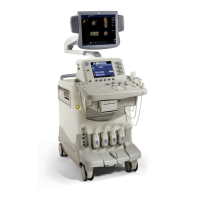Optimizing B-Mode
LOGIQ 7 Online Help 5-5
Direction 2392536-100 Rev. 1
B-Mode Scanning Hints
HINTS
These B-Mode controls produce the following results:
Auto Optimize. Improves imaging performance while reducing
optimization time. Available in B-Mode and Doppler Mode.
Coded Harmonics. Enhances near field resolution for
improved small parts imaging as well as far field penetration.
B Flow. Provides a more intuitive representation of non-
quantitative hemodynamics in vascular structures.
Frequency. Changes system parameters to best optimize for a
particular patient type.
Gray Map. Affects the presentation of B-Mode information.
Choose the closest gray map prior to making other
adjustments. There is an interdependency between gray maps,
gain, and dynamic range. If you change a map, revisit gain and
dynamic range settings.
Dynamic Range. Affects the amount of gray scale information
displayed. If you increase the gain, you may want to decrease
the Dynamic Range.
Edge Enhance. Affects the amount of border crispness.
Frame Average. Smooths the image by averaging frames.
Affects the amount of speckle reduction.
B Softener. Affects the amount of lateral smoothing.
TGC. Adjust TGC and keep Gain at a lower setting.
Focus Number/Position. The best focusing is at the focal
zone location. Put focal zone(s) at the area of interest. Be
conscious of where the focal zones are. Focal zones must be
moved to track at the center of the anatomy of interest.
Scan Area. Sizes region of interest. Adjust the Scan Area to
the smallest reasonable size to maximize frame rate.

